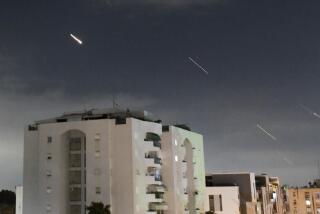Allied Assault Mapped to Rout Crippled Foe
- Share via
WASHINGTON — The massive U.S.-led ground assault against the Iraqi army that began early today was designed months ago to be a campaign of speed, deception and seamless maneuver with just one goal, senior Pentagon officials said Saturday: to crush a crippled adversary.
It is a plan for surrounding and destroying the heart of the Iraqi military force, not merely to drive it from Kuwaiti soil.
The offensive, which envisions simultaneous air, land and amphibious attacks across the entire front, contains no intermediate objectives or “firebreaks” where action would pause to allow an orderly Iraqi withdrawal.
Instead, military planners said Saturday, the campaign is designed to do to the Iraqi army exactly what Gen. Colin L. Powell, chairman of the Joint Chiefs of Staff, promised it would: Cut it off and kill it.
Multiple attacks will force the Iraqis to defend at numerous points and will mask the main assault, a 150,000-man armored and airborne thrust which Pentagon officials call “the hammer.”
And the attack will not stop until the hammer has fallen on the entire Iraqi field army, officials said.
A senior Army official said Iraqi troops will soon face only two alternatives: “They will either die in place or surrender.”
Senior military officials were confident, even cocky, Saturday, just hours before the offensive began. Officials with access to the war plan and current intelligence predict that the ground assault could be completed in as few as 14 days. They said it could claim fewer than 1,000 U.S. casualties.
They base their predictions on estimates that 40% to 50% of Iraqi military hardware in the theater has been destroyed, on the expectation of mass surrenders by enemy troops, on the unparalleled mobility of the allied force, on unchallenged air supremacy and on the long range of coalition weapons, which will allow the allied forces to engage the Iraqis at great distances.
A senior Army officer said Saturday that the battle pits Saddam Hussein’s “elegant World War I defenses against the most mobile army of the 20th Century.” He said the allies “will press the attack at a speed unheard of in military history.”
But nagging concerns remained.
Hussein could order terrorist attacks, officials said, unleash his poison gas stockpile or slaughter tens of thousands of Kuwaiti civilians.
“An animal in his death throes is most dangerous,” said a senior Pentagon official. “Saddam Hussein is in his death throes. He has nothing left to protect, nothing left to lose.”
Officials warned that the Iraqis retain 1,500 artillery pieces in the theater and unknown stores of chemical weapons that desperate Iraqi troops could fire at allied ground troops advancing into planned “killing zones.”
While that is one of the “dirtiest tricks” that Iraqi forces could use to thwart allied forces, it is only one of several that Iraq may employ to forestall defeat. Military commanders fear that the Iraqis may be readying their remaining combat aircraft for kamikaze strikes against allied troops or against Israel.
While no Iraqi combat aircraft have flown for two weeks, intelligence analysts have spotted maintenance work being done on some of the remaining warplanes, and many of Iraq’s best pilots remain in Iraq. During the Iran-Iraq War, Iraqi warplanes sprayed poison gas over the battlefield from aircraft, officials noted.
Military commanders also are fretting that Iraqi leaders could discern the direction of the main allied assault and move reinforcements into place to meet it.
But the allied ground campaign is designed to make it as difficult as possible for Iraqi commanders to understand where allied forces are moving and what their objectives are.
While the buildup to the attack, launched early today, robbed the allied assault of the element of strategic surprise, the intricate tactical plans are designed to keep Hussein’s forces guessing as to when, where and how allied units will attack. Any unexpected successes will be rapidly exploited, an Army official said, while units will cut their losses when defeated.
The most mobile and flexible unit under allied command is the 18th Airborne Corps, which includes the 101st Air Assault Division, the 82nd Airborne Division and the 24th Infantry Division (Mechanized). They were expected to be among the first U.S. units to move deep into Iraq, moving in 100-mile “leapfrogging” movements toward the heart of the Iraqi forces, the elite Republican Guard.
The 101st Air Assault Division, for instance, can travel miles into Iraq and establish forward arming and refueling points (“FARPs”), which can become the outposts of the main force’s advance. With little effort, the 101st can pick up its last staging post and turn suddenly in another direction, making it an ideal force both for high-speed maneuver and for flanking.
As the allies advance in different directions, they will “peel off” troops to hold Iraqi units in place and use the speed of helicopters, M-1 tanks and airborne forces to outflank, outrun and confuse slow-moving Iraq forces.
“We will be throwing sand in his eyes while we’re hitting him in the side and blaring rock music from a loudspeaker while a dog is nipping at his ankles. We want him to believe that a human wave is descending upon him,” said a knowledgeable Pentagon official.
One senior defense official familiar with the details of the overall battle plan said that the rapid and fluid movements are designed “to get inside the turning radius” of the Iraqi military, devising counters to the Iraqis’ reactions even before they have executed them.
Many Iraqi units have been made virtually immobile and unable to communicate with each other or higher commands by five weeks of aerial bombardment, officials said.
Intelligence analysts have concluded from the Iraqis’ performance at the Jan. 30 battle for the northeastern Saudi town of Khafji that coordination among Iraqi military units is crucial to their combat performance.
“Right now, the momentum is with us. Keeping the situation moving faster than they can react to it is key,” said the official.
Some of the 18,000 Marines afloat off the Kuwaiti coast may have been sent ashore or lifted deep inland in helicopters to deceive the Iraqis, forcing them to commit troops held in reserve in the heart of Kuwait. Meanwhile, the bulk of the amphibious force may have landed elsewhere or a more powerful armored force might be moved in from the rear of the Iraqi reserves and cut them off, a military official said.
More to Read
Sign up for Essential California
The most important California stories and recommendations in your inbox every morning.
You may occasionally receive promotional content from the Los Angeles Times.














